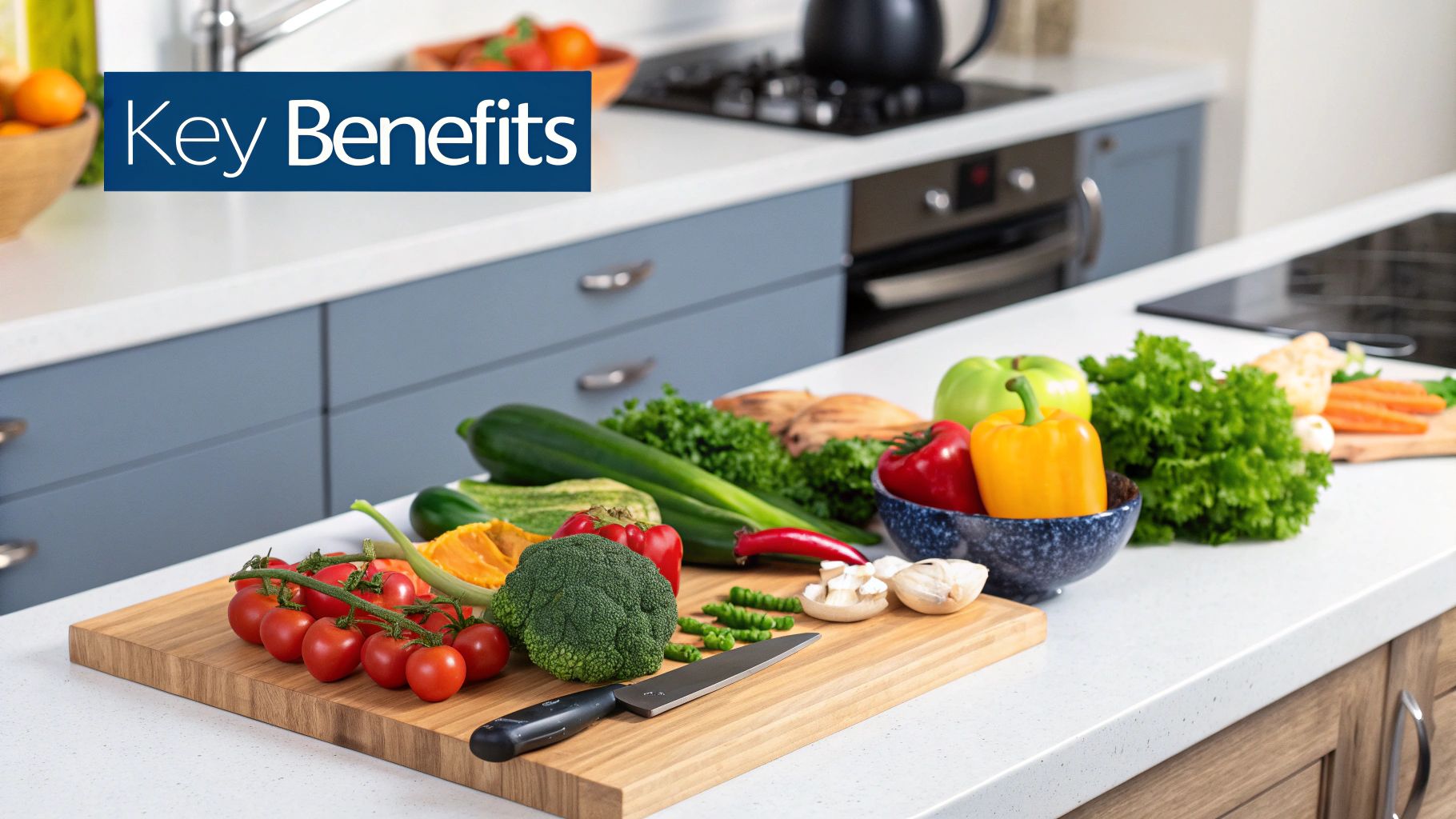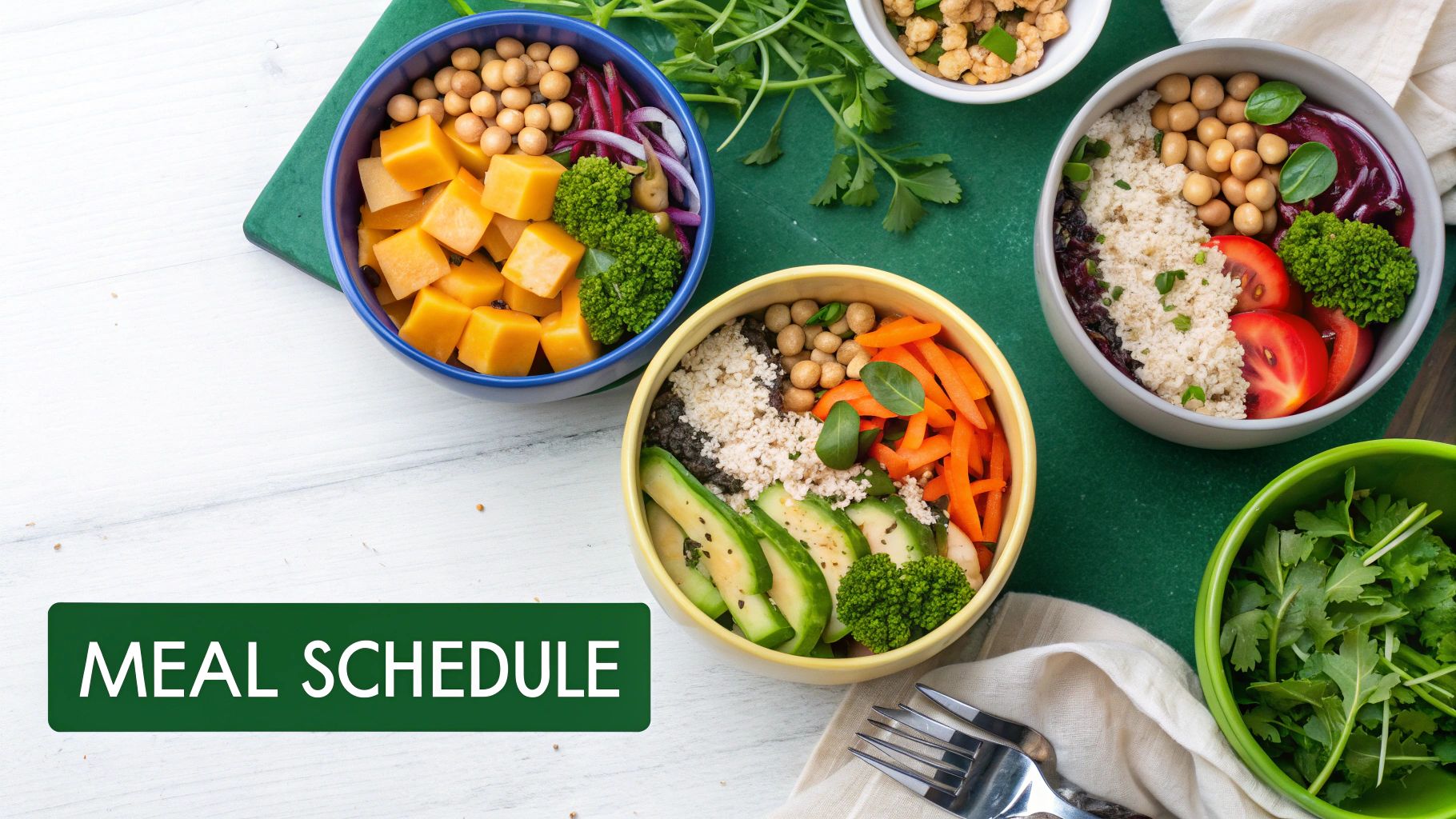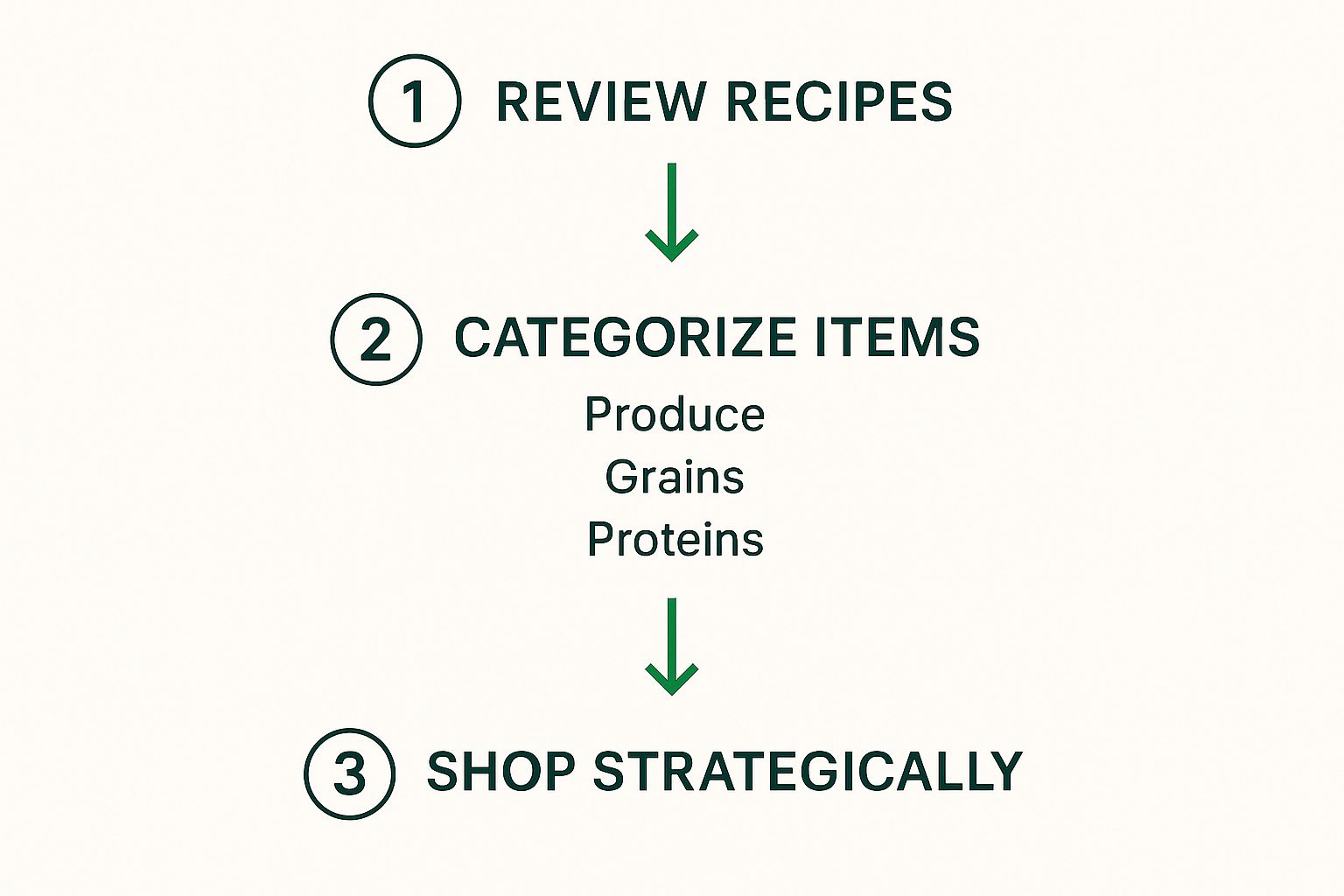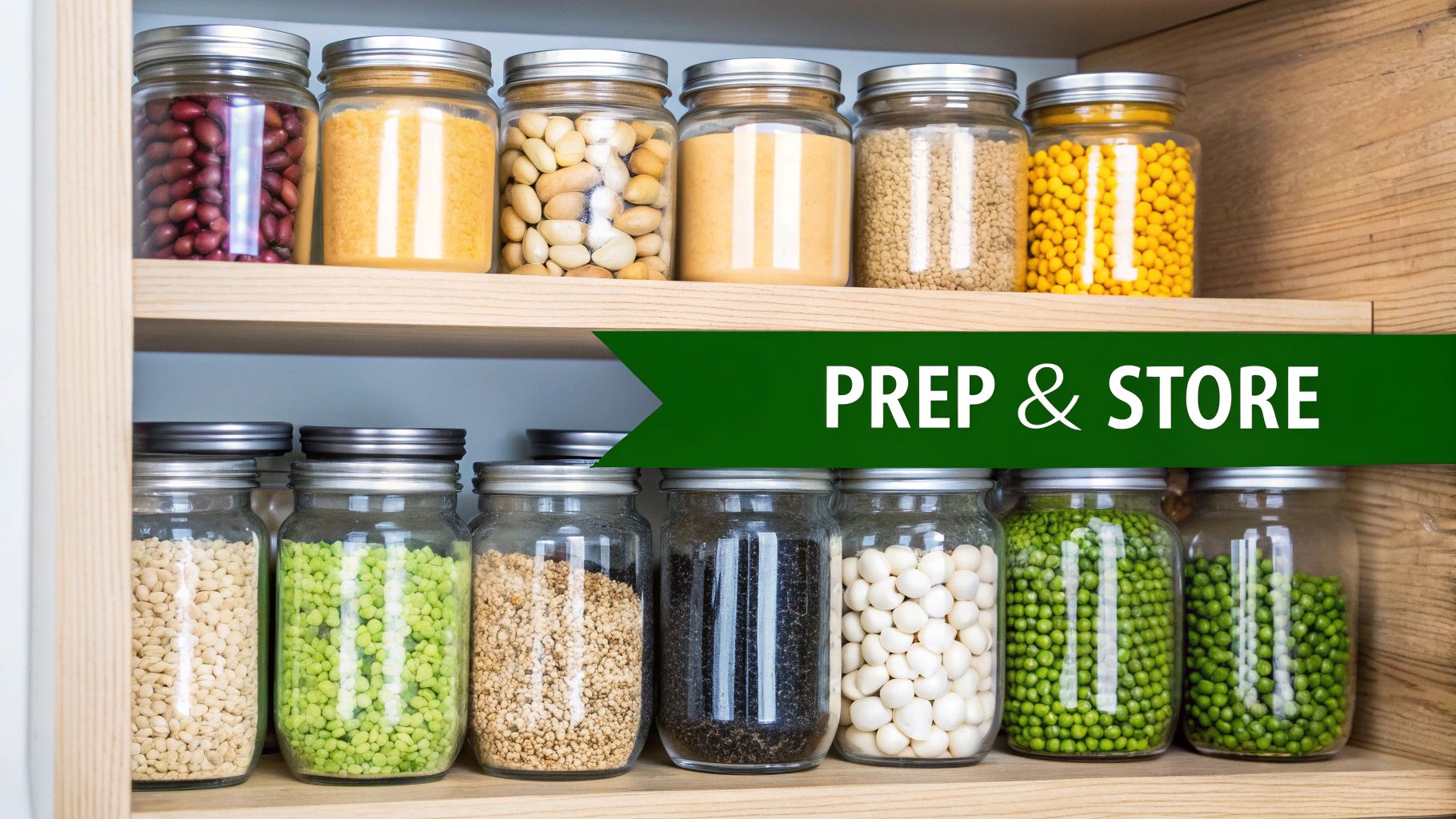A Weekly Vegetarian Meal Planner That Actually Works
Tired of the dinner scramble? Our weekly vegetarian meal planner guide has tips, templates, and AI tricks to make your kitchen life easier and tastier.
Ready to Simplify Your Meal Planning?
Get personalized meal plans and grocery lists automatically matched to your macro targets.

A Weekly Vegetarian Meal Planner That Actually Works
A weekly vegetarian meal planner is your secret weapon. It’s the ultimate defense against decision fatigue, sad, wilted produce, and those surprise takeout bills that always seem to hit when you're most vulnerable. Think of it as a simple, brilliant system for figuring out what to eat, building a lightning-fast grocery list, and finally winning back your evenings from the dreaded "what's for dinner?" panic.
Conquer Your Kitchen with a Smarter Meal Plan
Let's be honest, the 5 PM scramble is a soul-crushing experience. You get home, drop your keys, open the fridge, and just… stare. You're staring into a chaotic void of mismatched ingredients and absolutely zero inspiration. Next thing you know, you're tapping "reorder" on your favorite delivery app for the third time this week, feeling that familiar pang of guilt about the spinach slowly turning to liquid in the crisper.
A weekly vegetarian meal planner is your official exit strategy from that draining cycle. This isn't some rigid, joyless food prison that you'll abandon by Wednesday. Nope. It's a flexible framework that actually bends and flows with your real, messy life. This is your first real step toward taking back your time and maybe, just maybe, falling back in love with your kitchen.
The Real Payoff of Meal Planning
A solid plan is about so much more than just knowing what’s on the menu. When you get into the groove, you start to see real, tangible rewards almost immediately. We're talking about creating a week that's smoother, less stressful, and way more delicious.
Take a look at the tangible perks you get from adopting this simple habit.
#### The Real Payoff of Meal Planning
| Benefit Area | What You Actually Gain | How It Feels in Real Life |
| Reduced Food Waste | You plan around what you have and buy only what you need. | No more guilt-trips over throwing away slimy herbs or fuzzy bell peppers. |
| Significant Savings | Home-cooked meals are way cheaper than takeout or restaurant food. | That "aha!" moment when you check your bank account and see extra cash. |
| Less Daily Stress | You remove one huge decision from your daily to-do list. | The sweet, sweet peace of mind knowing dinner is already handled. Pure bliss. |
| Healthier Habits | You're in the driver's seat of your nutrition. | Feeling energized and proud because you're fueling your body with good stuff. |
Ultimately, a great meal plan doesn’t just organize your food; it organizes your life. It gives you back your precious evenings and can even turn cooking from a dreaded chore into a creative, enjoyable part of your day.
A great meal plan doesn’t just organize your food; it organizes your life. It gives you back your evenings and turns cooking from a chore into a creative and enjoyable part of your day.
At its core, a good weekly vegetarian meal planner is about empowerment. It's the tool that helps you go from feeling totally overwhelmed by your kitchen to feeling like you're in complete control. You’ll save a surprising amount of money, eat fantastic food, and finally silence that daily dinner dilemma for good. So forget boring salads and that one pasta dish you always make—get ready for a fun, sustainable way to make delicious vegetarian food your new normal.
Build Your Go-To Vegetarian Recipe Arsenal

Let's be honest, a meal plan is only as good as the food in it. This is where the magic really happens—building your personal library of knockout vegetarian dishes you actually get excited about eating. Forget bland, forget boring. Your mission is to create a "greatest hits" collection of meals that works for your life.
Think of it like building the ultimate music playlist. You need some quick, punchy tracks for those hectic weeknights (your 20-minute heroes) and some longer, more soulful albums for lazy weekend cooking sessions. This collection is the foundation, the very backbone of every weekly vegetarian meal planner you'll ever create.
And you're in good company! This whole plant-based thing isn't some tiny trend; it's a massive global shift. In 2025, there are over 1.5 billion vegetarians worldwide. The market for plant-based foods is exploding, set to hit a staggering $46.09 billion by 2033. What does that mean for you? It means there has never, ever been a better time to find incredible vegetarian recipes. You can dig into the full data on these vegetarian trends and see just how big the party has gotten.
Curate Your Culinary Collection
Okay, time to become a recipe hunter-gatherer. Start bookmarking posts from your favorite food blogs, saving those drool-worthy Instagram reels, and even snapping pics of recipes from cookbooks at the library. The secret is to keep everything in one central, organized spot. I'm a digital folder guy, but a good old-fashioned binder works just as well.
Here’s the pro move: organize your finds into categories that actually make sense for real life. This one simple step will make planning a thousand times easier.
- Quick Weeknight Wins (Under 30 Mins): Your one-pan pastas, hearty salads, and lightning-fast curries.
- Weekend Feasts (1 Hour+): This is for your epic lentil shepherd's pie, veggie lasagna, or that fancy brunch quiche.
- Pantry Raid Potentials: Meals you can whip up almost entirely from stuff you already have, like canned beans, pasta, and frozen veggies.
- "Wow" Factor Dishes: The impressive meal you bust out when you have company and want to show off a little.
Learn to 'Vegetarianize' Your Old Favorites
Going vegetarian doesn't mean saying goodbye to the flavors you grew up loving. So many classic meat-based dishes can be brilliantly adapted, and honestly, this is one of the most fun parts of building your new food roster.
Don't reinvent the wheel; just change the tires. Swapping meat for a plant-based alternative in a recipe you already love is the fastest way to build a meal plan that feels familiar and comforting.
Think about what made the original dish great—was it the texture? The savory flavor? Then make a smart swap. Here are a few easy trades to get you started:
| If You Miss... | Try This Vegetarian Swap... | Why It Works |
| Ground Beef in Tacos | Seasoned black beans or lentils | They give you that satisfying, hearty texture and soak up spices like a champ. |
| Chicken in Stir-Fries | Firm tofu or tempeh | Both get beautifully crispy on the outside and drink up all that delicious sauce. |
| Hearty Chili con Carne | A mix of kidney beans, pinto beans, and diced mushrooms | This combo creates a surprisingly complex, "meaty" texture and a deep, savory flavor. |
By finding and tweaking recipes, you’re doing more than just filling slots in a planner. You're building a personalized system that guarantees delicious, stress-free meals, week after week. This recipe arsenal is your single most valuable asset for making meal planning stick for good.
Master the Art of the Strategic Grocery List
So you've got your beautiful weekly vegetarian meal planner all mapped out. That's your blueprint. But the grocery list? That’s where the magic really happens, turning your brilliant ideas into delicious reality.
A well-built list is the unsung hero of meal planning. It's what stands between you and an hour of aimless wandering down every single aisle, grabbing snacks you don't need, and making that dreaded second trip for the one thing you forgot. We've all been there.
The first rule of a killer grocery list is surprisingly simple: “shop your kitchen” first. Before you even dream of grabbing your reusable bags, take a quick expedition through your own supplies. What’s hiding in the pantry? What produce is kicking around in the fridge? Got anything interesting in the freezer? You might discover you already own half the ingredients for that black bean soup you've been craving.
Organize Your List for a Grocery Store Speed Run
Alright, now that you know what you actually need, it's time to get strategic. The real pro move is organizing your list to match the layout of your favorite grocery store. This tiny tweak transforms a chaotic scramble into a swift, efficient mission. No more zig-zagging back and forth for the tomato paste. It's time to glide through those aisles like you own the place.
Try grouping everything into a few key categories:
- Produce: All your fresh fruits and veggies, right in one place.
- Pantry Staples: Grains, pastas, canned beans, spices, and oils.
- Refrigerated & Dairy: Tofu, tempeh, yogurt, cheese, and plant-based milks.
- Frozen Foods: An absolute must-have category for any savvy meal planner.
This isn't just about saving time—it's about saving money. When you have a plan, you're far less likely to be tempted by that strategically placed display of gourmet cookies. Your wallet will thank you.
A grocery list organized by store layout is your secret weapon against impulse buys and wasted time. It transforms shopping from a chore into a quick, strategic strike.
Embrace the Power of the Freezer Aisle
Don't just walk past the freezer section—it's a goldmine for anyone living a vegetarian lifestyle. Think of it as your ultimate backup plan for those nights when you just can't. A well-stocked freezer is a lifesaver.
Frozen spinach is perfect for dropping into curries, frozen berries instantly upgrade your morning oatmeal, and a bag of edamame makes for a fantastic protein-packed snack. The demand for these convenient options has absolutely exploded. The frozen vegetarian food market hit a staggering $15 billion in 2025 and is expected to rocket to nearly $26 billion by 2033.
What does that mean for you? More variety, better quality, and more delicious products than ever before. You can read more about the growth of frozen vegetarian options and see just how much it’s changing the game for home cooks.
By truly mastering your grocery list, you close the gap between planning a meal and actually enjoying it. It's the final, crucial step that gets delicious, stress-free vegetarian food on your table.
Your Sunday Meal Prep Workflow That Actually Works

Alright, this is where the rubber meets the road—or in our case, where the veggies meet the cutting board. Your brilliant plan is about to become real, delicious food. Sunday meal prep is how a tiny bit of effort on the weekend pays off in a huge way all week long.
But let's bust a huge myth right now. Meal prep does not mean you have to sacrifice your entire Sunday to a hot stove and a mountain of identical Tupperware containers. Forget that.
The real goal isn't to create a fridge full of sad, pre-portioned boxes that you'll be sick of by Tuesday. That’s just a recipe for boredom and takeout. Instead, we're going to embrace the absolute magic of component prepping.
The Genius of Component Prepping
Component prepping is all about making versatile building blocks, not finished meals. Think of it as being your own personal sous-chef. When you stumble in the door on a hectic Tuesday, half the work is already done. You just get to play with the fun parts—assembly and eating.
This is the secret sauce for a truly flexible weekly vegetarian meal planner. It gives you the freedom to mix and match ingredients based on what you’re actually craving, which completely sidesteps that classic "Ugh, I'm not in the mood for what I planned" problem.
So, what does a typical component prep session look like? It’s simpler than you think:
- Cook a versatile grain: Get a big batch of quinoa or brown rice going.
- Roast a sheet pan of veggies: I'm talking broccoli, bell peppers, and sweet potatoes tossed in olive oil and your favorite spices.
- Whip up a go-to sauce: A zesty lemon-tahini dressing or a simple vinaigrette can instantly elevate salads, bowls, and wraps.
- Prep your protein: Press and dice a block of tofu or simmer a pot of lentils.
By prepping these core elements, you’ve just unlocked endless meal combinations. That roasted broccoli can star in a frittata, bulk up a grain bowl, or get tossed into a quick pasta. The quinoa? It's the perfect base for a hearty salad or a filling for stuffed peppers. See? It's all about having options.
My One-Hour Power-Prep Routine
You really don't need hours for this. All it takes is one solid, focused power hour to set yourself up for a week of culinary calm. This is my personal workflow, fine-tuned to get the most done in the least amount of time.
- First 15 Mins (The Chop Shop): Crank up your favorite playlist and get all your chopping out of the way. Wash and prep every vegetable you'll need for the next few days—onions, garlic, carrots, celery, you name it. Store them in airtight containers. Honestly, this is the single biggest time-saver of the entire week.
- Next 25 Mins (The Active Waiting Game): Now, get the oven and stove to do the heavy lifting. While your veggies are roasting and the quinoa is simmering, you have this glorious "passive" cooking time. I use these 25 minutes to blend a sauce, wash and spin-dry a bunch of salad greens, or hard-boil a few eggs.
- Final 20 Mins (Cool Down & Pack Up): This step is crucial! Let everything cool down completely before you pack it away. Shoving warm food into containers creates condensation, which is the fast track to soggy, sad results. I swear by clear glass containers so I can see exactly what I have with a quick glance into the fridge.
Forget spending your whole Sunday chained to the kitchen. An hour of smart, focused component prepping is infinitely more effective than five hours of exhaustive cooking. This is the definition of working smarter, not harder.
This simple routine gives you a massive head start on the week. It transforms weeknight cooking from a chore into a quick, creative assembly job. This is how your meal plan stops being just a document and starts being a living, breathing part of a less stressful, more delicious life.
Let an AI Build Your Perfect Meal Plan
Picture this: your meal planner not only knows you despise cilantro but also remembers your goal to cook more Thai food this month. What if it could whip up a week of delicious, veggie-packed meals, track the nutrition, and then hand you a perfectly sorted grocery list? This isn't science fiction; it's exactly what AI-powered tools are making possible today.
Platforms like Meal Flow AI are designed to take the grunt work completely off your plate. Think of it as the ultimate shortcut for anyone who’s too busy to plan but refuses to settle for boring, unhealthy meals. You just tell it what you like, and the AI handles the rest.
Honestly, this kind of help couldn't come at a better time. We know that while tons of people want to eat more plant-based meals, not nearly as many actually pull it off. There's a real gap between intention and action, and tools like this are bridging it. With some experts predicting over 10% of the world could be vegetarian or vegan by 2030, smart planners are about to become indispensable. You can read more about the plant-based boom to see why getting a little help from technology makes so much sense.
How AI Gets to Know You (and Your Stomach)
Getting started is surprisingly painless. Instead of you losing an evening to the black hole of recipe blogs, the AI just needs a little info to get going.
It'll typically ask about things like:
- Dietary Rules: Any allergies? Gluten-free? Dairy-free? Let it know the non-negotiables.
- Flavor Profiles: Are you a fiend for Italian, a sucker for Mexican, or all about Indian curries?
- Your Schedule: Got 20 minutes on a weeknight but more time on the weekend? It'll adjust.
Using your answers, the system dives into a massive recipe database to piece together a plan that actually fits your life. It builds in variety—so you're not stuck with lentil soup three times a week—and even gets clever about using overlapping ingredients to cut down on food waste and save you money. The rest of that cilantro from Tuesday's tacos? It might just pop up in Thursday's black bean burgers.
Here’s a peek at what a finished plan from Meal Flow AI can look like, complete with visuals that'll actually make you excited to cook.

The clean, visual layout gives you a great overview of the week ahead, making it easy to see what’s for dinner and get inspired.
From Plan to Pantry in a Few Clicks
But here’s where the real magic happens. Once you’ve approved your meal plan, the AI instantly generates a shopping list, sorted by aisle. No more scribbling on napkins or forgetting the one thing you actually needed.
An AI planner doesn't just hand you a list of recipes; it delivers a ready-to-go, actionable shopping list that bridges the gap between planning to eat well and actually doing it.
By taking over the tedious jobs of finding recipes, checking ingredients, and making a list, the AI transforms a couple of hours of weekly drudgery into a task that takes just a few minutes.
Your Top Meal Planning Questions, Answered

Even with the best intentions, jumping into a weekly vegetarian meal planner can throw you a few curveballs. So let's talk about the real-world problems that pop up when you're trying to make meal planning a real, lasting habit. I get these questions all the time, so here are some quick, practical answers.
This is where the rubber meets the road. You’ve got your plan, your fridge is stocked... and then life happens. Getting ahead of these common sticking points is how you build a system that can actually handle your real life.
What if I’m Not in the Mood for What I Planned?
This is the big one. It's the number-one reason meal plans get tossed out the window. You had a hearty lentil shepherd's pie scheduled for Tuesday, but when Tuesday rolls around, all you can think about is tacos. The solution? Build in some wiggle room from the get-go.
Don't lock yourself into a rigid, unforgiving menu. Think of it more like a flexible framework. Here’s what I do:
- Schedule a "Free Night": I always block out one night a week for whatever I'm feeling—takeout, a random craving, or just a bowl of fancy cereal. It's a built-in escape hatch.
- Embrace Component Prepping: Remember how we talked about prepping ingredients, not just full meals? This is why. That pre-cooked lentil filling for the shepherd's pie? Add some cumin and chili powder, and boom—you've got instant taco filling. Problem solved.
The most successful meal planners I know aren't rigid; they're masters of the pivot. Think of your plan as a helpful suggestion, not an unbreakable contract you signed with your kitchen.
How Do I Handle Leftovers Without Getting Bored?
Ah, leftovers. They can be a total lifesaver or a one-way ticket to food fatigue. The secret to actually enjoying your leftovers is to think "repurpose," not just "repeat." It’s all about giving last night's dinner a fun new disguise.
For example, that leftover chili doesn't have to be just another bowl of chili. The next day, it can be an amazing topping for baked potatoes or nachos. Those extra roasted veggies from Monday? They’re the perfect filling for a Wednesday morning frittata. By completely changing the format, you trick your brain into thinking it’s a whole new meal.
How Can I Plan Without Spending All Sunday Cooking?
Yeah, no one wants to lose an entire weekend day to the kitchen. That's a major turn-off. The good news is, you absolutely don't have to. Smart, focused prep is way more effective than those marathon cooking sessions. Don't even try to cook everything for the whole week.
Instead, zero in on the little tasks that create bottlenecks on busy weeknights. Pre-chopping your onions, garlic, and peppers is a game-changer. Whipping up one versatile vinaigrette can elevate salads and grain bowls all week long. Honestly, a single hour of this kind of strategic prep is more valuable than five hours of exhausting yourself at the stove.
Why Is My Grocery Bill Still So High?
You're planning every single meal, so your food budget should be shrinking, right? If your grocery bill is still giving you sticker shock, it usually comes down to a few common culprits.
First, always shop your own kitchen before you make a list. Seriously. Check what you already have hiding in the pantry, fridge, and freezer. Second, build your meals around seasonal produce—it's always cheaper and tastes a million times better. Finally, fully embrace budget-friendly proteins like beans, lentils, and tofu. Planning your week around ingredients you can buy in bulk is a surefire way to see some real savings.
---
Ready to let technology handle all the planning, lists, and logistics for you? Meal Flow AI creates personalized vegetarian meal plans based on your tastes and sends an organized shopping list straight to Instacart. Stop planning and start cooking with Meal Flow AI today!